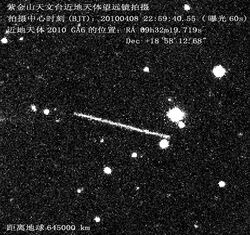Astronomy:2010 GA6
 2010 GA6, captured by Purple Mountain Observatory in 8 April 2010 | |
| Discovery[1][2] | |
|---|---|
| Discovered by | CSS |
| Discovery site | Mount Lemmon Obs. |
| Discovery date | 5 April 2010 |
| Designations | |
| 2010 GA6 | |
| Minor planet category | NEO · Apollo[1][3] Mars-crosser |
| Orbital characteristics[3] | |
| Epoch 23 March 2018 (JD 2458200.5) | |
| Uncertainty parameter 6 | |
| Observation arc | 4 days |
| |{{{apsis}}}|helion}} | 3.6863 AU |
| |{{{apsis}}}|helion}} | 0.9292 AU |
| 2.3078 AU | |
| Eccentricity | 0.5973 |
| Orbital period | 3.51 yr (1,281 days) |
| Mean anomaly | 87.507° |
| Mean motion | 0° 16m 51.96s / day |
| Inclination | 9.7541° |
| Longitude of ascending node | 197.67° |
| 34.334° | |
| Earth MOID | 0.0040 AU (1.6 LD) |
| Physical characteristics | |
| Mean diameter | 22 m (72 ft)[4] 19 m (est. at 0.20)[5] 36 m (est. at 0.057)[5] |
| Absolute magnitude (H) | 25.9[4] · 26.0[3] |
2010 GA6 is a micro-asteroid on an eccentric orbit, classified as a near-Earth object of the Apollo group. It was first observed on 5 April 2010, by astronomers of the Catalina Sky Survey at Mount Lemmon Observatory, Arizona, United States, four days before a close approach to Earth at 1.1 lunar distances on 9 April 2010.[1][2] It has not been observed since.[1]
Orbit and classification
2010 GA6 is an Apollo asteroid. Apollo's cross the orbit of Earth and are the largest group of near-Earth objects with nearly 10 thousand known members. It orbits the Sun in the inner main-belt at a distance of 0.93–3.69 AU once every 3 years and 6 months (1,281 days; semi-major axis of 2.31 AU). Its orbit has a high eccentricity of 0.60 and an inclination of 10° with respect to the ecliptic.[3] With an aphelion of 3.69 AU, it is also a Mars-crossing asteroid, as it crosses the orbit of the Red Planet at 1.666 AU.[3]
Close approach
With a 1-day observation arc, 2010 GA6 had a 1 in 6 million chance of impacting Earth in 2074.[6] It was removed from the Sentry Risk Table on 8 April 2010.[7] The asteroid has now a minimum orbital intersection distance with Earth of 599,000 km; 372,000 mi (0.004005 AU),[3] which corresponds to 1.6 lunar distances, and is notably larger than the nominal distance of its 2010-flyby.
2010 flyby
On 9 April 2010, 02:07 UT, the asteroid passed Earth at a nominal distance of 434,000 km; 270,000 mi (0.0029 AU) or 1.1 lunar distances.[4][3] A stony asteroid 22 meters in diameter can be expected to create an air burst with the equivalent of 300 kilotons of TNT at an altitude of 21 kilometers (69,000 ft).[8] Generally only asteroids larger than 35 meters across pose a threat to a town or city.[9] There are no projection of future close approaches to Earth available.[3]
Physical characteristics
According to NASA astronomers, 2010 GA6 measures approximately 22 meters (72 ft) in diameter.[4] Based on a generic magnitude-to-diameter conversion, the asteroid measures between 19 and 36 meters in diameter, for an absolute magnitude of 22.6, and an assumed albedo between 0.057 and 0.20, which represent typical values for carbonaceous and stony asteroids, respectively.[5]
Numbering and naming
This minor planet has neither been numbered nor named.[1]
See also
References
- ↑ 1.0 1.1 1.2 1.3 1.4 "2010 GA6". Minor Planet Center. https://www.minorplanetcenter.net/db_search/show_object?object_id=2010+GA6. Retrieved 15 February 2018.
- ↑ 2.0 2.1 "MPEC 2010-G23 : 2010 GA6". IAU Minor Planet Center. 2010-04-05. http://www.minorplanetcenter.net/mpec/K10/K10G23.html. Retrieved 2013-02-08. (K10G06A)
- ↑ 3.0 3.1 3.2 3.3 3.4 3.5 3.6 3.7 "JPL Small-Body Database Browser: (2010 GA6)". Jet Propulsion Laboratory. https://ssd.jpl.nasa.gov/sbdb.cgi?sstr=3514890;cad=1. Retrieved 15 February 2018.
- ↑ 4.0 4.1 4.2 4.3 "Asteroid to Fly by Within Moon's Orbit Thursday". NASA/JPL. 6 April 2010. https://www.jpl.nasa.gov/news/news.php?release=2010-115. Retrieved 15 February 2018.
- ↑ 5.0 5.1 5.2 "Asteroid Size Estimator". CNEOS NASA/JPL. https://cneos.jpl.nasa.gov/tools/ast_size_est.html. Retrieved 15 February 2018.
- ↑ "Observations of small Solar-System bodies". hohmanntransfer. 2010-04-07. http://www.hohmanntransfer.com/mn/10/10097_0407.htm#2010GA6. Retrieved 2013-02-08. (1.6e-07 = 1 in 6,250,000 chance)
- ↑ "Date/Time Removed". NASA/JPL Near-Earth Object Program Office. http://neo.jpl.nasa.gov/risk/removed.html. Retrieved 2012-03-19.
- ↑ Robert Marcus; H. Jay Melosh (2010). "Earth Impact Effects Program". Imperial College London / Purdue University. http://impact.ese.ic.ac.uk/ImpactEffects/. Retrieved 2013-02-04. (solution using 22 meters, 2600kg/m^3, 17km/s, 45 degrees)
- ↑ Will Ferguson (January 22, 2013). "Asteroid Hunter Gives an Update on the Threat of Near-Earth Objects". Scientific American. http://blogs.scientificamerican.com/observations/2013/01/22/asteroid-hunter-gives-an-update-on-the-threat-of-near-earth-objects/. Retrieved 2013-01-23.
External links
- MPEG, Minor Planet Electronic Circular, 5 April 2010
- Newfound Asteroid to Buzz Earth Thursday, Foxnews
- Newly Discovered Asteroid Will Pass by Earth April 8, UniverseToday.com
- 2010 GA6 at NeoDyS-2, Near Earth Objects—Dynamic Site
- Ephemeris · Obs prediction · Orbital info · MOID · Proper elements · Obs info · Close · Physical info · NEOCC
- 2010 GA6 at ESA–space situational awareness
- 2010 GA6 at the JPL Small-Body Database
 |

